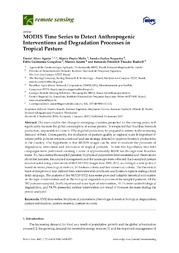MODIS Time Series to Detect Anthropogenic Interventions and Degradation Processes in Tropical Pasture.
MODIS Time Series to Detect Anthropogenic Interventions and Degradation Processes in Tropical Pasture.
Author(s): AGUIAR, D. A.; MELLO, M. P.; NOGUEIRA, S. F.; GONÇALVES, F. G.; ADAMI, M.; RUDORFF, B. F. T.
Summary: The unavoidable diet change in emerging countries, projected for the coming years, will significantly increase the global consumption of animal protein. It is expected that Brazilian livestock production, responsible for close to 15% of global production, be prepared to answer to the increasing demand of beef. Consequently, the evaluation of pasture quality at regional scale is important to inform public policies towards a rational land use strategy directed to improve livestock productivity in the country. Our hypothesis is that MODIS images can be used to evaluate the processes of degradation, restoration and renovation of tropical pastures. To test this hypothesis, two field campaigns were performed covering a route of approximately 40,000 km through nine Brazilian states. To characterize the sampled pastures, biophysical parameters were measured and observations about the pastures, the adopted management and the landscape were collected. Each sampled pasture was evaluated using a time series of MODIS EVI2 images from 2000?2012, according to a new protocol based on seven phenological metrics, 14 Boolean criteria and two numerical criteria. The theoretical basis of this protocol was derived from interviews with producers and livestock experts during a third field campaign. The analysis of the MODIS EVI2 time series provided valuable historical information on the type of intervention and on the biological degradation process of the sampled pastures. Of the 782 pastures sampled, 26.6% experienced some type of intervention, 19.1% were under biological degradation, and 54.3% presented neither intervention nor trend of biomass decrease during the period analyzed.
Publication year: 2017
Types of publication: Journal article
Unit: Embrapa Territorial
Observation
Some of Embrapa's publications are published as ePub files. To read them, use or download one of the following free software options to your computer or mobile device. Android: Google Play Books; IOS: iBooks; Windows and Linux: Calibre.
Access other publications
Access the Agricultural Research Database (BDPA) to consult Embrapa's full library collection and records.
Visit Embrapa Bookstore to purchase books and other publications sold by Embrapa.

